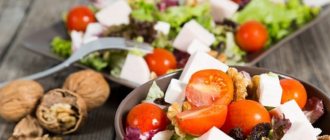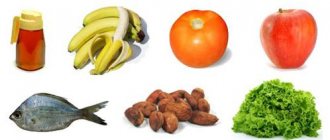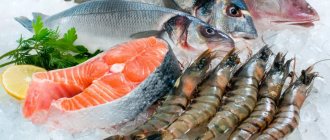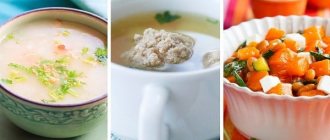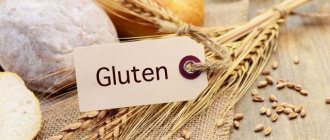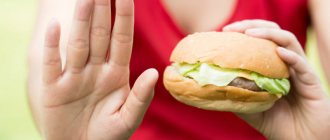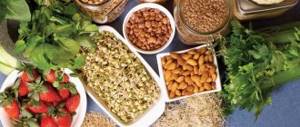The 6th table diet is a therapeutic diet, the purpose of which is to reduce the formation of uric acid in the body by limiting animal proteins, fats and salt, as well as actively removing existing acid from the body.
Diet table 6 is prescribed if it is necessary to reduce the consumption of animal proteins and fats for the following diseases:
- gout;
- gouty nephropathy;
- idiopathic and symptomatic hyperuricemia (increased uric acid in the blood);
- urolithiasis (with uraturia and oxaluria).
At the same time, you should know that diet 6 is not prescribed for acute and chronic renal failure, namely:
- with nephropathy with signs of renal failure;
- with hyperuricemia against the background of chronic renal failure.
Diet rules table 6
Therapeutic diet 6 tables is a complete diet with normal energy value (2500-2800 kcal), which can be followed for a long time. At the same time, in the process of compiling the menu, recommendations on the daily chemical composition of food are followed:
- proteins – 70-80 grams;
- fats – 80-90 grams;
- carbohydrates – 400 grams.
It is also important to monitor the amount of sugar (no more than 80 grams per day, including cooked foods) and salt (10 grams). Dietary food table 6 should include the following vitamins and microminerals:
- retinol, beta-carotene, ascorbic and nicotinic acids, thiamine, riboflavin;
- sodium, magnesium, iron, potassium, calcium, phosphorus.
You need to drink up to 3 liters of liquid per day, including soups, compotes, etc. A large volume of drinking promotes the active functioning of the kidneys and the excretion of uric acid in the urine. Also for this purpose, you can eat fresh fruits and vegetables with diuretic properties: apples, pears, watermelons, plums, cucumbers.
In order to achieve relief from symptoms of gout, it is necessary not only to change the diet, but also to adhere to the rules of eating diet No. 6, namely:
- fractional meals in small portions (5-6 times a day);
- you need to drink alkaline mineral water, juices, compotes, etc.;
- if you are obese, you should reduce the amount of baked goods in your diet to a minimum;
- patients with gout are prohibited from fasting, since fasting increases the amount of uric acid in the blood, which leads to worsening gout symptoms;
- meat and fish are prepared in only one way: boiled in a large amount of water, since 50% of the purine compounds from meat products go into the broth.
Pevzner diet: all tables
Diet modes 0 to 15 are prescribed for various diseases . But in reality there are many more food options, since some of them are divided into subcategories.
The duration of use of the Pevzner diet depends on the disease itself, but it is best to consult a doctor who will select the most suitable diet plan taking into account the diagnosis
Brief description of diets according to Pevzner:
- Diet No. 0 is prescribed immediately after surgery. It is the strictest, since the total calorie content is only 1200 Kcal. The amount of salt is minimal, no more than 2 grams. Solid food is prohibited, since it is necessary to relieve the gastrointestinal tract as much as possible.
- Diet No. 1 is prescribed to patients who have various diseases of the duodenum and stomach, and oncological diseases of the digestive tract. The diet is based on vegetable soups and soft porridges. The Pevzner diet is also indicated for gastritis. It is especially effective if the disease is only at the initial stage of development. It is strictly forbidden to eat foods that are too hot or cold, so as not to damage the intestinal walls. The table is divided into two subcategories - “A” and “B”, primarily they are aimed at relieving pain due to gastritis and stomach ulcers. Most often, power system No. 1 is not used for more than two weeks.
Therapeutic diet No. 1 according to Pevzner
- Diet No. 2 is used for chronic diseases of the gastrointestinal tract and liver. Foods with added sugar are prohibited, as their frequent consumption can lead to the development of diabetes.
- Diet No. 3 is indicated if the patient has chronic constipation, so the diet consists of foods that help normalize stool. These are mainly vegetables, kefir, lean meat, cottage cheese. It is also worth noting that frequent constipation can cause other unpleasant phenomena: arrhythmia, frequent headaches. Diet No. 3 will help cope with this problem.
- Diet No. 4 is prescribed for various intestinal diseases. It is also divided into several categories: 4A is used for colitis, 4B is indicated for its chronic form, 4B is prescribed to patients who are in the recovery stage. According to the rules, all dishes must be consumed only warm. The menu consists of various cereals, boiled vegetables and purees. Food is consumed 5 times a day in small portions.
Therapeutic diet No. 4 according to Pevzner
- Diet No. 5 is aimed at normalizing liver function. In addition, it can be used if the patient has previously had their gallbladder removed. It is also used for pancreatitis and cholecystitis.
- Diet No. 6 is indicated for patients with gout and patients with urolithiasis. It is based on fractional nutrition, that is, eating up to 6 times a day in small portions. The menu consists of vegetable salads, fruits, berries, and dairy products. Smoked and flour products are prohibited.
- Diet No. 7 is indicated for kidney disease. The table is also divided into two subcategories: 7A for exacerbation, 7B - when the patient is at the recovery stage.
- Diet No. 8 is suitable for people who are obese or want to lose weight. The Pevzner diet for obesity involves a complete abstinence from soda, sweets, fatty foods, and starchy foods.
Therapeutic diet No. 8 according to Pevzner
- Diet No. 9 is prescribed to patients with diabetes. The menu is designed in such a way that the sugar level gradually decreases. The basis of the diet is low-fat fish, cottage cheese, mushrooms, and vegetables. Meals should also be fractional, so the insulin level will always be at the same level.
- Diet No. 10 is prescribed to patients with heart disease, vascular disease or circulatory failure. The ban includes soda, alcohol, processed foods, flour products, and fast food. Table No. 10 can also be used for high cholesterol. In addition, it is divided into two subcategories: 10C for vascular atherosclerosis and 10G for hypertension.
- Diet No. 11 is prescribed to patients with tuberculosis, people with low hemoglobin, or pregnant women. The diet consists of lean fish, meat, vegetables, dairy products, vegetables and cereals.
Therapeutic diet No. 11 according to Pevzner
- Diet No. 12 is prescribed for those who need to restore the nervous system. All foods that stimulate the nervous system are prohibited: alcohol, fatty, fried, spicy foods. The menu is based on dairy products, dried fruits, and eggs.
- Diet No. 13 is prescribed to patients with acute infectious diseases. In acute cases of the disease, it is forbidden to eat stewed, fried, baked foods.
- Diet No. 14 is prescribed for stones in the urine. You need to eat up to 4 times a day according to the following scheme: 400 grams of carbohydrates, 100 grams of proteins and fats.
- Diet No. 15 is designed to smoothly transition from medical nutrition to regular nutrition. The diet consists of eggs, cereals, vegetables, fruits and hot drinks. The diet helps the body get used to regular foods without putting it into a stressful state.
Therapeutic diet No. 15 according to Pevzner
Diet 6 table - what you can and cannot eat (table)
The lack of protein on the table 6 diet is compensated for by a large amount of dairy products (cottage cheese, sour cream, yogurt, etc.), which are consumed both raw and in the form of casseroles, lazy dumplings, jelly, etc.
| Categories | What can you eat | What not to eat |
| Flour products | Bread made from wheat and rye flour | Baking from butter and puff pastry |
| Meat and poultry | Low-fat varieties (rabbit, veal, turkey) boiled or baked 2-3 times a week | Fatty meats and poultry, offal (brains, liver, kidneys, tongue), canned food, smoked meats, pickles. Fried meat. Meat broths |
| Fish | Low-fat boiled fish 2-3 times a week | Fatty fish, salted, smoked fish, canned fish, fish roe |
| Fats | Butter (including ghee) and vegetable oils | Pork, beef, lamb fats, lard, margarine |
| Dairy | Milk, cottage cheese, sour cream, yogurt, kefir | Fatty and salty cheeses, sour cottage cheese |
| Eggs | 1 egg per day | |
| Cereals | Cereals are not limited to diet No. 6 | Legumes |
| Soups | Soups with vegetable broths, dairy | Meat, fish and mushroom broths. With sorrel, peas, beans |
| Vegetables | Almost everything raw and cooked | Salted and pickled mushrooms, sorrel, rhubarb, spinach, cauliflower |
| Fruits and berries | Almost all varieties of fruits and berries, including citrus fruits | Figs, raspberries |
| Dessert | Jam, jam, pastille, marmalade, meringues. Milk jelly | Chocolate |
| Beverages | Fruit and berry jelly, compotes, juices, kvass. Weak tea, coffee. Alkaline mineral waters | Strong black tea, strong coffee, cocoa. Alcoholic drinks |
The essence of diet 6 for gout
The sixth diet table, together with other numbered medical and dietary tables, was developed by the Soviet doctor and nutritionist Mikhail Pevzner.
The 6th table diet he founded should be used for the following diagnoses:
- Uric acid diathesis;
- Gout;
- Oxaluria, uraturia, cystinuria and other urolithiasis.
The nutritional principle of diet-table No. 6 is to limit salts, proteins and fats and exclude foods containing extractive nitrogenous substances or purines and oxalic acid. The main advantage in the diet is given to vegetables, dairy products and fruits. Diet - table No. 6 normalizes purine metabolism, cleanses the body of harmful compounds and specifically affects the formation of uric acid, reducing it.
Chemical composition and nutritional calorie content of health table diet number 6:
- 90 gr. fats (30% is given to vegetable fats, 70% to animal origin);
- 400 gr. carbohydrates;
- 80 gr. proteins (50/50 plant and animal);
- The drinking norm is about 2.5 liters;
- 8-10 gr. sodium chloride or salts;
- 2700 kcal - calorie content of meals per day.
The sixth table - the diet includes the following mandatory products in its food list:
- Dairy foods - sour cream, kefir, cream, yogurt, cottage cheese, milk, yogurt;
- Cereals – any of your choice, but in very moderate quantities
- Fish, poultry, meat - any low-fat varieties;
- Vegetables - carrots, tomatoes, beets, white cabbage, peppers, pumpkin, zucchini, cucumbers;
- Eggs, but no more than one per day;
- Rye, bran, wheat bread;
- Fruits, berries, dried fruits (dried apricots, prunes);
- Drinks – jelly, natural juices, milk tea (black, green), fruit drinks, decoctions;
- Butter, olive and vegetable oils;
- Honey, marmalade, jam.
Fatty meats, salty cheeses, mushrooms, sorrel, red cabbage, legumes, spinach, rhubarb, pastry, raspberries, figs and cranberries are completely excluded from the therapeutic diet of the diet - table No. 6. In addition to these products, it is prohibited to include meat, chicken, mushroom and fish broths, soups and sauces, smoked meats, marinades and pickles, spicy snacks and strong drinks in the diet menu.
Important rules for using the sixth table diet:
- You should eat at least five times every day;
- Fish and meat products (pre-boiled before further preparation) can be consumed no more than three times a week.
Monday
Tuesday
Thursday
Friday
Saturday
Sunday
Weekly menu for table 6
When drawing up the 6 table diet menu, the daily need for proteins, fats and carbohydrates is taken into account. To do this, an increased amount of low-fat dairy products, vegetable fats and cereals is introduced into the diet.
Monday
- Breakfast: oatmeal with diluted milk and fruit.
- Snack: cottage cheese casserole with sour cream, juice.
- Lunch: borscht in vegetable broth with sour cream, boiled meat, buckwheat, stewed carrots.
- Afternoon snack: pear, tea with honey.
- Dinner: milk jelly.
Tuesday
- Breakfast: millet porridge with milk, dried fruits, compote.
- Snack: fruit and berry jelly and biscuits.
- Lunch: cabbage soup, steamed fish, mashed potatoes, boiled red beet salad.
- Afternoon snack: soft-boiled egg, yogurt.
- Dinner: lazy dumplings with cottage cheese and fruit sauce.
Wednesday
- Breakfast: a sandwich of black bread with a boiled egg or butter, tea.
- Snack: homemade yogurt with fruits and berries.
- Lunch: rice soup, vegetable stew with meat, berry compote.
- Afternoon snack: cottage cheese casserole, compote.
- Dinner: kefir.
Thursday
- Breakfast: buckwheat milk porridge, juice.
- Snack: marshmallows, rosehip infusion, apple.
- Lunch: okroshka, dumplings with homemade low-fat minced meat, sour cream, tea.
- Afternoon snack: fruit jelly.
- Dinner: cottage cheese with yogurt and berries.
Friday
- Breakfast: low-fat cheese sandwich, coffee.
- Snack: lazy dumplings with cottage cheese, compote.
- Lunch: buckwheat soup with vegetable broth, mashed potatoes, 1 egg omelette, fresh vegetable salad.
- Afternoon snack: manna, yogurt.
- Dinner: kefir, biscuits (3 pcs.).
Saturday
- Breakfast: oatmeal with milk, banana and apple, fruit juice.
- Snack: sandwich, tea.
- Lunch: borscht with sour cream, sweet rice porridge with fruit jam.
- Afternoon snack: steamed fish, Chinese cabbage salad.
- Dinner: curd mixture with fruit.
Sunday
- Breakfast: biscuits, tea, banana.
- Snack: dumplings with cottage cheese, sour cream.
- Lunch: vegetable soup, spaghetti, boiled meat, salad, fruit juice.
- Afternoon snack: fruit.
- Dinner: milk jelly, marmalade.
What is possible, what is not
Diet No. 6 according to Pevzner increases the amount of alkaline foods consumed.
Can:
- Wheat, rye and bran bread;
- Vegetarian soups, dietary cabbage soup, rassolnik, beetroot soup and okroshka;
- Dairy products – cottage cheese, sour cream, milk, yogurt, kefir, fermented baked milk, yogurt;
- Vegetables – the more the better;
- Fresh fruits and berries in large quantities, various dishes made from them;
- Sweets include preserves, jams, marmalade, marshmallows and honey;
- From fats you can use butter and vegetable oils as a dressing for ready-made dishes;
- Black and green tea with milk or lemon, fruit and vegetable juices, jelly, compotes, chicory drink, decoctions, fruit drinks.
It is possible, but with reservations:
- Any cereals and pasta, but in very limited quantities;
- Lean meats and poultry 2-3 times a week;
- Lean fish, but not more than 3 times a week;
- Eggs of any preparation, no more than 1 piece per day;
- Hard cheeses, all except salty varieties.
Animal proteins (meat, poultry, fish) should be consumed only in boiled form. Otherwise, the products will contain a large amount of oxalic acid purines, which are limited by table No. 6.
Dairy products do not contain oxalic acid, and play an important role in restoring metabolism. For gout and urolithiasis, they must be included in the daily menu. But if the patient suffers from renal colic, you need to be stricter with milk - the products contain calcium, which is already in excess in the urine.
It turns out that the diet for gout focuses on fruits, vegetables and all dairy products.
Table 6 for gout excludes foods that contain a lot of oxalic acid and purines. While following a therapeutic diet, you should not consume:
- Butter dough, especially hot pastries;
- Salty cheeses;
- Fatty meat and fish, sausages;
- Legumes and nuts;
- Meat and fish broths, fatty soups and borscht;
- Hot sauces and snacks;
- Chocolate;
- Alcohol.
If renal colic dominates in gout, you should never skip meals or force the body to starve. The diet should be sufficiently high in calories. If renal colic is accompanied by excruciating sharp pain, the patient must be provided with complete rest and constant access to fluid throughout the day.
Dish recipes
Table 6 diet recipes should consist of simple ingredients that do not irritate the kidneys and the excretory system as a whole. If gout is combined with excess weight, you should reduce your calorie intake by using simple carbohydrates (flour, sugar, sweets) and add more fresh and stewed vegetables to your diet.
Red cabbage and beet salad
For the salad you will need red cabbage (small), red beets (2 pieces), nuts (30 g), lemon juice, honey (1 teaspoon), salt.
The beets are pre-boiled and grated on a medium grater. Red cabbage is chopped, salted and left for 10 minutes. Next, the ingredients are thoroughly mixed, honey is added, sprinkled with lemon juice and vegetable oil, and sprinkled with nuts.
Meat puree with rice
To prepare meat puree, you need the following products: meat (300 g), rice (raw 30 g), herbs.
It is necessary to boil the meat, cut into pieces and grind in a meat grinder or blender. Rice is also boiled and washed. Next, mix the prepared rice and chopped meat, and mince the minced meat again through a meat grinder.
The meat mass is salted, beaten, and placed on low heat. Stirring thoroughly, bring the puree to a boil and add vegetable oil.
Before serving, the dish is decorated with herbs.
Potatoes baked with caraway seeds
To prepare the dish, take potatoes (400 g), vegetable oil, cumin.
Peel the potatoes, cut them into halves and bring to a boil in salted water. After boiling, drain the water, place the potatoes on a greased baking sheet, grease the top with vegetable oil, and sprinkle with caraway seeds.
Bake in the oven for 40 minutes. Serve baked potatoes with herbs and vegetables.
Recipes
To create a menu for every day with gout, there are many delicious and healthy recipes - first, second and desserts.
Vegetable soup
To prepare this dish you will need the following ingredients:
- 2 medium potatoes;
- 1 small carrot;
- Onion head;
- Half a liter of water;
- Greens and a pinch of salt.
Bring water to a boil and add finely chopped potatoes and cook for 10 minutes. Finely chop or grate the carrots, simmer in vegetable oil, and add to the soup. Cut the onion into half rings and chop the parsley. Add to soup and cook for another 10 minutes. Add salt and sprinkle with herbs at the end of cooking. Serve soup for lunch.
Stuffed zucchini
The dish is perfect for dinner. You will need the following ingredients:
- Small zucchini;
- 50 grams of rice;
- Carrot;
- Half a head of onion;
- Vegetable oil;
- Greenery;
- Salt;
- Tomato paste.
Cut the zucchini lengthwise and remove the core. Boil for 5 minutes. Boil the rice until half cooked. Grate the carrots on a coarse grater, cut the onion into half rings. Sauté onions and carrots in vegetable oil, add tomato paste and herbs. Mix vegetables with rice. Place the mixture into the zucchini halves and simmer, covered, or bake for 15 minutes.
Fruit salad
The dish is suitable for breakfast or afternoon snack. To prepare it, take fresh fruits:
- Apple;
- Pear;
- Banana;
- Orange.
The fruits are peeled and seeds removed, cut into small pieces and a spoonful of honey and 100 grams of natural yogurt are added. If desired, you can add raisins and dried apricots.
Fruit salad is the basis of dietary nutrition
The full menu of diet number 6 for the week with recipes for patients is written by nutritionists.
For children
Diet number 6 is often prescribed to children with hyperuricemia, since almost all categories of foods can be consumed on therapeutic nutrition, with the help of which the need for nutrients, vitamins and microelements is met for children of any age.
Pasta casserole with cottage cheese
Ingredients for preparing the casserole: pasta (100 grams of dry mass), cottage cheese (200 grams), one egg, sugar (2 tablespoons), vanillin (pinch), sour cream, breadcrumbs.
General characteristics of this diet
The considered diet number 6 for gout is one of the 16 standard treatment tables developed by professor of medicine M.I. Pevzner more than 100 years ago. By changing the diet and removing certain foods from it, clear positive results can be achieved in patients. For those who suffer from gout, the 6 classic diet helps prevent exacerbations, prolong remission and maintain good health.
Improvements are achieved by sharply reducing the consumption of foods rich in purines, oxalic acid, and salt (sodium chloride). Protein and fat-containing meals are moderately limited. Instead, the volume of food that alkalizes the body (vegetables, fruits and berries, milk, etc.), as well as free liquid, increases.
You need to eat fractionally, from 4 to 6 times a day. Dishes are served at regular temperature. On an empty stomach, as well as between meals, be sure to take liquid. The total calorie content of the diet should be up to 2600-2900 kcal. In this case, proteins and fats are consumed at 80 - 90 g per day, and carbohydrates - up to 400 g. It is recommended to slightly reduce the amount of table salt. Be sure to provide a sufficient supply of all necessary vitamins and microelements.
Fasting, including therapeutic fasting, is categorically contraindicated for gouty arthritis - it provokes an increase in the level of uric acid in the blood, hence the development of an attack. But diet 6 for gout recommends fasting days once a week. You can make them with milk, kefir, compote, curd, fruit or vegetable. In the absence of contraindications for the cardiovascular system, it is recommended to drink at least 2.5 liters of liquid per day of unloading.
Excess weight with gout is only harmful, so you shouldn’t overeat
[back to contents]
Menu for patients with gout
The principle of the menu is based on the exclusion from the diet of foods high in purines and oxalic acid. A limit is imposed on salt consumption - no more than 10 g per day. At the same time, the menu includes products that can produce an alkalizing effect (vegetables, milk). The amount of protein consumed should be no more than 80 g. Fats can be consumed no more than 90 g. Carbohydrates should be limited to a limit of 400 g. Liquid consumption - from 2 liters. Nutrition for gout occurs five times a day, for a total of 2000-3000 kcal.
What is table 6 in dietary nutrition?
What is diet table 6, a menu for every day with this diet, healthy recipes for dietary dishes, all this is of great interest to those people who need to choose a diet for uric acid diathesis and those who are interested in therapeutic dietary nutrition. So we will try to answer these questions in the following article.
So here it is:
Table No. 6 is recommended for patients with gout, people with urolithiasis who form stones from uric acid, called uraturia, or oxalic acid stones - oscaluria. The same diet is prescribed for uric acid diathesis, cystinuria and other diseases for which it is recommended to limit meat and fish products in the diet. This diet normalizes metabolism, reduces the formation of uric acid and its salts in the body, shifts the urine reaction to the alkaline side, and normalizes intestinal function.
Nutrition Features:
Table No. 6 is characterized by the following features: a significant limitation of foods containing purines and oxalic acid, as well as a limitation of salt and an abundance of alkalizing foods, that is, vegetables, fruits, milk. It is also recommended to increase the amount of free fluid. The content of proteins and fats should be somewhat limited.
When preparing food, following diet No. 6, they adhere to the usual culinary processing of products, with the exception of processing meat, poultry and fish. These products must be boiled first. This is necessary because during cooking, 50% of the purines contained in the product go into the broth. When meat, fish or poultry are boiled, you can then prepare stewed, baked, fried dishes from them. It is important to adhere to the rule of including meat and fish dishes in your diet no more than two to three times a week. In this case, one serving of meat should be no more than 150 g, a serving of fish - about 170 g.
A split diet is recommended - four to six times a day. In between meals, as well as on an empty stomach, you must take additional fluid. The food temperature should be normal.
People with gout, while following diet No. 6, are also recommended to arrange fasting days for themselves once a week. They can be dairy, fruit, curd, kefir. On a fasting day, you need to drink at least 2.5 liters of fluid, unless there are contraindications from the cardiovascular system. Treatment with fasting days with such a diagnosis, on the contrary, is strictly contraindicated.
Chemical and energy composition of table No. 6: proteins – 80–90 g, fats – 80–90 g, carbohydrates – 400 g; calorie content – 2600–2900 kcal; retinol – 0.5 mg, carotene – 7 mg, thiamine – 1.5 mg, riboflavin – 2 mg, nicotinic acid – 15 mg, ascorbic acid – 150 mg; sodium - 4 g, potassium - 3.5 g, calcium - 0.75 g, phosphorus - 1.3 g, magnesium - 0.45 g, iron - 0.035 g. Table salt is consumed in slightly reduced quantities.
Dos and don'ts:
Table No. 6 recommends the following dishes and products.
Bread is allowed any of the 1st and 2nd grade flour, wheat and rye, bran.
Appetizers include salads made from fresh and pickled vegetables.
Soups should be vegetarian, such as borscht, cabbage soup, vegetable potato soups with the addition of cereals.
Meat, poultry and fish are lean, as mentioned above, initially boiled.
Among dairy products, milk, fermented milk products, cottage cheese and dishes made from them are useful.
Any cereals are allowed in moderation.
Eggs are also allowed in any culinary preparation, but no more than one per day.
Any vegetables except legumes are allowed to be consumed.
Fruits and berries should be included in the diet in increased quantities; they can be raw or in any culinary processing, as well as dried fruits.
For drinks and sweet dishes, you can eat milk and fruit jelly, marmalade, marshmallows, honey, and jam. In order to improve the alkaline environment in the body, citrus fruits, such as lemon or grapefruit, and alkaline mineral waters are included in the diet.
Sauces in the diet should be based on vegetable broth, and tomato or milk sauce is also allowed. If a person suffers from gout, then drinking 1 glass of liquid before bed is very useful. This can be weak tea, tea with milk or lemon, kefir, juices, or a decoction of wheat bran.
Products and dishes that will have to be excluded when observing table No. 6. These include all soups with meat, fish and mushroom broths, as well as sorrel and legume soups. Frozen meats are not allowed in meat dishes, and the same goes for fish. Also excluded are canned meat and fish, liver, kidneys, tongue, sausage, smoked meats, and salted fish. As for fats, beef, lamb and cooking fats should be removed from the diet. Among snacks, the ban applies to salted cheeses.
Vegetables that are excluded from diet number 6 are legumes, as well as pickles and pickled vegetable dishes. Among cereals, restrictions apply to dried cereals, with the exception of refined rice, refined wheat and milled wheat. Sauces based on meat, fish and mushroom broths are also excluded.
Among sweet dishes and drinks, it is undesirable to consume chocolate, raspberries, cranberries, cookies, confectionery products prepared with salt or powdered sugar, such as strong tea and coffee. Another exception is dried fruits, except prunes. You should also limit foods that excite the nervous system. In addition to the already mentioned coffee and tea, these are also spices and savory snacks. We must also remember that drinking alcohol can provoke gout attacks, since alcohol impairs the excretion of uric acid by the kidneys.
Diet, table 6, menu for every day. Great video!
And more on this topic:
Sample menu:
- First breakfast: fresh cucumbers, oatmeal with milk, rose hip decoction.
- Second breakfast: cottage cheese with sour cream, fruit jelly.
- Lunch: potato soup, zucchini stuffed with rice and vegetables, with sour cream sauce, strawberries with milk.
- Dinner: cottage cheese pancakes, cabbage cutlets with butter, tomato juice.
- At night: fresh apples.
Useful recipes:
Vegetable soup:
75 g potatoes, 20 g carrots, 20 g onions, 5 g parsley root, 5 g butter, 5 ml vegetable oil, 500 ml water, 3 g parsley.
Place coarsely chopped potatoes into boiling water and bring to a boil. Then add chopped carrots and stewed in butter, chopped onions sautéed in vegetable oil and parsley roots. Cook all vegetables until fully cooked. When the soup is ready, sprinkle the soup with herbs.
Vegetarian borscht with cheese:
100 g cabbage, 60 g carrots, 120 g potatoes, 60 g tomatoes, 50 g beets, 30 g butter, 10 g flour, 10 g parsley, cheese, salt.
Potatoes, carrots and tomatoes must be taken without skins and seeds. Cut them into slices and shred fresh cabbage. Place vegetables in boiling water and cook. 15 minutes before the end of cooking, add grated beets, add salt and cook the borscht until the beets are ready. When serving, sprinkle the dish with chopped parsley. Serve grated cheese separately with the borscht.
Cabbage cutlets:
170 g white cabbage, 40 ml milk, 15 g ghee, 20 g semolina, 1/4 egg, 10 g flour, 20 g sour cream.
Finely chop the cabbage (you can grate it) and simmer with milk and butter. As soon as the cabbage becomes soft, add semolina and heat until thickened. Cool the resulting mass a little, add a raw egg and mix everything. With wet hands, form cutlets, bread them in flour and fry until golden brown. Serve with sour cream.
Fresh cabbage salad:
150 g fresh white cabbage, 10 ml vegetable oil, lemon juice.
Finely chop the cabbage, sprinkle with lemon juice and grind a little to release the juice. Then place on a plate, pour oil to taste and serve.
Cabbage and apple salad:
100 g cabbage, 50 g apples, vegetable oil.
Finely chop the cabbage and cut the apples into small cubes. Combine the products, pour oil and mix.
Raw potato pancakes:
200 g potatoes, 20 g flour, 1/2 egg, 50 g sour cream, 15 ml vegetable oil.
Peel large potato tubers and grate them on a fine grater. Drain the separated juice, and add flour, egg yolk and part of the sour cream to the main mass. Mix everything well and combine with the whipped egg white. Gently stir the dough. Then take it with a spoon and place it in a well-heated frying pan with oil. Fry the pancakes this way. Serve with sour cream.
Pancakes with curd:
30 g flour, 160 ml milk, 20 g butter, 1 egg, 40 g sugar, 60 g cottage cheese, 40 g sour cream, 4 g vanilla sugar, 10 g raisins.
Mix eggs with milk and flour, add some sugar and salt. Bake pancakes from the resulting dough, fry them on both sides in butter. Beat the remaining sugar with the eggs, add cottage cheese, raisins and mix thoroughly. Spread the prepared mixture onto pancakes, roll them into rolls, sprinkle with vanilla sugar and pour in sour cream. Serve warm.
Cottage cheese casserole:
75 g cottage cheese, 50 ml milk, 8 g sugar, 2 egg whites, 15 g sour cream, 3 g butter.
Wipe the cottage cheese. Add milk, egg white, sugar and mix everything well. Place the prepared mass on a greased baking sheet. Then brush the casserole with sour cream and bake in the oven. When serving, sprinkle with sour cream.
Apples baked in an egg white omelet:
Whites of 2 eggs, 25 g apples, 15 g butter, 50 ml milk.
Peel the apples and cut into small pieces. Then combine the fruits with proteins and milk. Pour the resulting mixture into a frying pan with oil and fry, covering with a lid. Roll the finished omelette into a pie and serve immediately.
Source:
Based on the book by A. Sinelnikova “Dietary nutrition. Culinary recipes for your health."
General rules
The rules are general in nature, but it is extremely important to adhere to their comprehensive implementation. There are a number of rules, the implementation of which allows you to make the hypopurine diet effective for gout:
- Meat can only be eaten boiled. After 10-15 minutes of cooking, you need to drain the first broth, which will significantly reduce the level of purine substances in the finished dish.
- Fish and meat can be consumed two to three times a week in quantities of no more than 170 grams.
- In case of exacerbation of gout, it is not recommended to eat meat and fish; you need to switch to a vegetarian diet.
- One day a week should be a fasting day. On this day, food should consist of vegetables, fruits, kefir and cottage cheese. Water consumption needs to be increased.
Varieties
Patients diagnosed with obesity or those with gout during an exacerbation are prescribed a type of diet - 6E, which is short-term in nature. Its rules provide for reducing the daily energy value of food to 2,000 kcal. The consumption of proteins (up to 70 g), fats (up to 80 g) and simple carbohydrates (up to 250 g) is reduced. Meals are transferred to a strictly fractional principle: in small portions. Drinking plenty of fluids is recommended, salt intake is limited.
Authorized Products
It is necessary to develop a taste and habit of eating certain foods that make a decisive contribution to the effectiveness of the hypopurine diet and the normalization of the patient’s condition. For convenience, the list of allowed diet foods for gout is presented in table form:
Potatoes, eggplants, carrots, zucchini, cucumbers, tomatoes
Oranges, plums, pears, apples, apricots
With bran, wheat
Marshmallow, marshmallow, jam
Milk, fermented baked milk, kefir, curdled milk, yogurt
Diet No. 6 (table No. 6) is a therapeutic nutrition system that is prescribed during the treatment of gout and various urolithiasis.
Diet No. 6 (Table No. 6). Food
What can you eat on diet number 6:
Soups: vegetarian borscht, cabbage soup, vegetable soups, with various cereals, okroshka, beetroot soup, dairy soups.
Cereals: any, but in limited quantities.
Vegetables, herbs: in increased quantities, raw and cooked in any form.
Meat, fish: low-fat varieties (veal, beef, chicken, turkey, hake, etc.). We include meat and fish in the diet 3 times a week (meat 150 g or fish 160-170 g).
Eggs: 1 egg per day.
Fresh fruits and berries: consumed in large quantities fresh, as well as in various culinary preparations.
Dairy products: milk, kefir, sour cream, cottage cheese and any dishes made from it, hard cheese.
Sweets: milk creams and jelly, marmalade, non-chocolate candies, marshmallows, jam, honey.
Flour products: rye and wheat bread made from 1st and 2nd grade flour. Baking with bran.
Fats: vegetable, butter and ghee.
Drinks: tea with lemon, milk, weak coffee, fruit and vegetable juices, fruit drink, kvass, rosehip decoction, compotes with berries and fruits.
What not to eat on diet number 6:
- any broths and sauces based on broths; — canned foods, marinades and pickles; — soups with legumes and sorrel; - mushrooms, rhubarb, spinach, cauliflower, sorrel, green beans, peas; — by-products; - salted and smoked fish, meat, cheeses, sausages; - cocoa, chocolate, strong tea and coffee; - raspberries, cranberries; — dried fruits (except prunes); - mustard, horseradish, black pepper; - baked goods, confectionery products with powdered sugar; - alcoholic drinks.
Pevzner diet menu
Pevzner has developed 16 tables that are aimed at combating a specific problem.
Table No. 0 is known as the “surgical diet.” The patient uses special mixtures for tube feeding:
- sweet tea;
- jelly;
- low-fat meat broth.
One serving is only 300 grams, in addition, the number of meals reaches up to 7 times a day.
Table No. 1 is prescribed for people suffering from ulcers, gastritis, and reflux pathology. The list of permitted products includes:
- non-sour jam;
- all vegetables and fruits, except radishes, cabbage, sorrel, citrus fruits;
- all cereals, only millet is prohibited;
- chicken, turkey, beef, lean fish, rabbit;
- soups from vegetables, milk;
- vegetable oil;
- milk, cream, condensed milk, sour cream, cottage cheese;
- bread made only from wheat flour.
Prohibited products:
- canned food, even homemade pickles.
Table No. 2 is indicated for gastritis and colitis, so the menu consists of:
- vegetable soups, meat, fish broth;
- lean, boiled meat;
- buckwheat, rice, oatmeal;
- cottage cheese, kefir;
- boiled vegetables;
- coffee, tea, cocoa, fruit juices.
Contraindicated for use:
- bell pepper, radish.
Therapeutic diet menu No. 2 according to Pevzner
The menu of table No. 3 is similar to the previous food system, the only difference is that tea and coffee are prohibited. For chronic diarrhea, table No. 4 is used, which consists of the following products:
- boiled vegetables and fruits, they are ground before consumption;
- porridge;
- tea, unpackaged fruit juices and decoctions of rose hips and blueberries.
Diet No. 5 is prescribed to patients with cholecystitis and cholelithiasis, so the diet consists of:
- any fruits and berries;
- vegetable or milk soups;
- lean meats;
- all porridges;
- kefir, sour cream, milk, yogurt;
- all vegetables except mushrooms and radishes.
Table No. 6 is characterized by an abundance of vegetables and fruits that have been subjected to heat treatment. Mushrooms, sausages, meat by-products and rich broths, sweets, and legumes are excluded from the menu
Therapeutic diet menu No. 6 according to Pevzner
The diet of diet No. 7 is similar to the diet of an ordinary average person, except that salt is excluded from the dishes.
Since table No. 8 is aimed at combating obesity, sugar-containing, fatty foods and butter are excluded from the menu.
Table No. 9 is aimed at combating diabetes, so the amount of carbohydrates is limited. The menu consists of vegetables, soups and cereals.
Table No. 10 assumes that the daily calorie intake will not exceed 2200 units. Carbonated drinks, sweets, fast food, alcohol, and processed foods are removed from the diet.
Table No. 11 is prescribed for people who are sick with tuberculosis. The menu includes:
- vegetable or meat broth soups;
- lean meat;
- sour cream, milk and cottage cheese;
- all cereals;
- any vegetables and fruits.
Diet No. 12 is used for central nervous system disorders. Therefore, everything that could somehow affect it is excluded. These products include: coffee, tea, all products containing cocoa, and alcoholic beverages.
Diet No. 13 is indicated for acute respiratory and infectious diseases. The menu is based on vegetables, soups and fruits. There is a ban on smoked products.
Table No. 14 involves a complete abstinence from milk, fermented milk products, smoked and fatty foods, fruits, spicy seasonings, and vegetables. The menu is based on porridge, pasta, lean fish and meat.
Diet No. 15 involves eating only light foods, excluding hard-to-digest, spicy, and fatty foods.
Therapeutic diet menu No. 15 according to Pevzner
Diet No. 6 (table No. 6): menu for the week
Diet No. 6 is varied and beneficial for the body. Below is a sample menu for the week.
Meat and fish should be boiled and eaten boiled or stewed.
In addition to food, do not forget to drink 2-2.5 liters of fluid per day.
Monday
Breakfast: salad of fresh carrots, cabbage and cucumber, a piece of bread with bran and rosehip decoction. Lunch: rowan decoction, boiled egg, carrot + pumpkin salad; Lunch: milk soup, zucchini cutlets with potatoes, compote. Afternoon snack: cottage cheese with fruit. Dinner: vegetable cabbage rolls, milk.
Tuesday
Breakfast: cheesecakes, fruit jelly, kefir. Lunch: cereal with milk; Lunch: soup with zucchini, boiled fish, mashed potatoes. Afternoon snack: milkshake with fruit. Dinner: salad (egg, carrots, croutons, sour cream), corn porridge, ryazhanka.
Wednesday
Breakfast: cottage cheese casserole, carrot and apple juice. Lunch: yogurt with cereal. Lunch: vegetable soup, cabbage salad, tomato juice. Afternoon snack: fruit jelly, fruit; Dinner: oatmeal, baked vegetables, tea.
Thursday
Breakfast: cottage cheese and carrot casserole, oatmeal with apple, compote. Lunch: milk soup. Lunch: buckwheat, beef cutlet, stewed cabbage, juice. Afternoon snack: fruits or berries. Dinner: pasta, beet salad with vegetable oil, jelly.
Friday
Breakfast: sweet rice with apples, juice; Lunch: fruit. Lunch: vegetarian borscht, carrot cutlets, milk. Afternoon snack: kefir, fruit. Dinner: rice with bell pepper, pancakes with fruit, compote.
Saturday
Breakfast: vegetarian okroshka, juice or compote. Lunch: fruit with low-fat cream. Lunch: stewed vegetables, kefir. Afternoon snack: carrot-apple juice. Dinner: fresh vegetable salad, chicken fillet, fruit drink.
Menu for every day
Table No. 6 for gout implies frequent and fractional meals: portions should be small, 250-300 milliliters and consumed every 2-3 hours, that is, 5-6 times a day.
To make the diet easy and avoid temptations, you need to create a menu in advance taking into account the energy value of the diet, the recommendations of the urologist and your taste preferences.
Menu option for the week:
Monday
- Breakfast: 1 soft-boiled egg and vegetable salad with olive oil;
- Lunch: baked pumpkin;
- Lunch: milk noodle soup;
- Afternoon snack: potato soup with corn grits;
- Dinner: boiled pollock fillet, fresh orange juice.
Tuesday
- Breakfast: milk pudding with raisins, an hour with lemon;
- Lunch: 1 banana or orange;
- Lunch: Boiled potatoes with sauerkraut;
- Afternoon snack: apple casserole;
- Dinner: steamed curd pudding with blueberry jam, chicory drink.
Wednesday
- Breakfast: barley porridge with tomatoes;
- Lunch: vegetable pudding;
- Lunch: okroshka with kefir, boiled chicken fillet and salad;
- Afternoon snack: vinaigrette, compote of dried apples and prunes;
- Dinner: vegetable cabbage rolls, berry jelly.
Thursday
- Breakfast: protein omelet and salad with tomatoes and cucumbers;
- Lunch: applesauce and banana;
- Lunch: semi-viscous buckwheat porridge, stewed zucchini with carrots;
- Afternoon snack: milkshake;
- Dinner: curd mass, berry compote.
Friday
- Breakfast: oatmeal with prunes and milk;
- Lunch: pancakes with jam, chamomile infusion;
- Lunch: milk oatmeal soup, potato balls baked in sour cream;
- Afternoon snack: carrots stewed in cream;
- Dinner: vegetable stew, a glass of kefir.
Saturday
- Breakfast: sandwich of bran bread, butter, tea;
- Lunch: 100 grams of marshmallow or marmalade, lingonberry jelly;
- Lunch: soup with zucchini and carrots;
- Afternoon snack: Greek salad, apple and carrot juice;
- Dinner: apricot mousse with mint.
Sunday
- Breakfast: boiled chicken breast with broccoli, green tea with milk;
- Lunch: lazy dumplings with sour cream;
- Lunch: mashed potatoes with zucchini pancakes;
- Afternoon snack: beetroot and apple salad, bran broth;
- Dinner: a glass of fermented baked milk.


